Full-Scale Lateral Load Test of Large-Diameter Drilled Shaft for Building Construction on Marine Deposits
Abstract
1. Introduction
2. Site Description and Soil Profile
2.1. Test Site
2.2. Subsurface Conditions
3. Test Setup and Procedure
3.1. Instrumentation of FBG Sensor
3.2. Test Pile Construction
- (1)
- The pile construction began with the insertion of an outer diameter (O.D.) of the 2500 mm casing as the drilling progressed. Excavation of the pile was performed using a reverse circulation drill (RCD), and an airlift was utilized for cleaning purposes.
- (2)
- After cleaning the base, the reinforcing cage was inserted into the excavation.
- (3)
- Once the pile reached its tip, the reinforcing cage assembly was allowed to settle the excavation under its weight.
- (4)
- A 300 mm O.D. concrete delivery pipe (e.g., tremie pipe) was assembled and inserted into the reinforcing cage to extend near the tip of the pile.
- (5)
- Concrete was then pumped through the tremie pipe into the base of the pile until the top of the concrete reached an elevation of −1 m.
- (6)
- The 2500 mm O.D. casing was removed during the concrete placement, and the remaining casing was taken out the following day.

3.3. Setup for Full-Scale Lateral Pile Load Test
4. Test Results and Analysis
4.1. Measurements of Lateral Pile Load Test
4.1.1. Load–Displacement Curve
4.1.2. Bending Strain Measurement
4.2. Inverse Analysis for Characterizing Various Types of Pile Behavior
4.3. Estimation of p-y Curves
4.4. Coefficient of Horizontal Subgrade Reaction (kh)
5. Conclusions
- Based on a comprehensive investigation into the horizontal behavior of a large-diameter drilled shaft in marine deposits in Songdo, South Korea, this study analyzed various pile characteristics essential for the construction and design of buildings and infrastructures intended for marine deposits. As a result of the full-scale lateral load test on the large-diameter drilled shaft with a diameter of 2.5 m and a length of about 40 m, the maximum moment generated at the design load of 900 kN was 3520.2 kN, with a corresponding lateral displacement of 2.32 mm. Additionally, pile failure was anticipated at an applied load of 1710 kN, with the corresponding lateral deflection being 11.30 mm.
- Advanced instruments such as Fiber Bragg Grating (FBG) sensors have proven critical for accurately measuring displacement and strain along the shaft, essential for constructing precise load–displacement curves and understanding responses to lateral loads. It is expected that further studies involving real-time motion observations (e.g., earthquakes and floods) will benefit from the advantages of fiber optic sensors, enabling long-term measurements.
- Inverse analysis techniques using LPILE software validated the experimental results, confirming the accuracy of load–displacement data and providing deeper insights into force and moment distributions within the shaft. The maximum moment value, the location of its occurrence, and the lateral displacement were verified through inverse analysis and a comparison of measured values. As a result, it was confirmed that the maximum moment value and its corresponding lateral displacement matched well, with the point of maximum moment occurring approximately at 10 m depth. However, while the result at the design load of 900 kN showed good agreement, there was a significant discrepancy at the failure load, suggesting that there are challenges in using LPILE to assess pile behavior under ultimate conditions.
- This research contributes to developing depth-dependent p-y curves tailored to marine deposits, vital for predicting lateral soil–pile interaction and optimizing drilled shaft design under similar geological conditions.
- Practical implications include using derived p-y curves and insights into soil stiffness variations (the coefficient of horizontal subgrade reaction, kh) to enhance the stability and performance of drilled shaft foundations in reclaimed offshore areas like Songdo, South Korea. An empirical equation was proposed, utilizing the SPT-N value for the prediction of the kh value. This empirical equation was evaluated using metrics such as RMSE, MAPE, and R2, demonstrating fairly high prediction accuracy.
Author Contributions
Funding
Data Availability Statement
Conflicts of Interest
References
- Reese, L.C. Design and construction of drilled shafts. J. Geotech. Eng.-ASCE 1978, 104, 95–116. [Google Scholar] [CrossRef]
- Kulhawy, F.H. Drilled shaft foundations. In Foundation Engineering Handbook; Springer: Boston, MA, USA, 1991. [Google Scholar]
- O’Neill, M.W.; Reese, L.C.; Barnes, R.; Wang, S.T.; Morvant, M.; Ochoa, M. Effects of stratigraphic and construction details on the load transfer behavior of drilled shafts. Transp. Res. Record. 1992, 1336, 50–56. [Google Scholar]
- Sanping, Z.; Robert, L. Stability analysis of drilled shafts reinforced slope. Soils Found. 2002, 42, 93–102. [Google Scholar] [CrossRef]
- Wang, W.; Wu, J.; Li, Y. Super-long bored pile foundation for super high-rise buildings in China. In Proceedings of the 18th International Conference on Soil Mechanics and Geotechnical Engineering-Challenges and Innovations in Geotechnics, Paris, France, 2–7 September 2013; pp. 2897–2900. [Google Scholar]
- Taghavi, A.; McVay, M.; Niraula, L.; Davidson, M.; Patil, A. Axial and lateral resistance coupling in the analysis of large-diameter drilled shafts. Eng. Struct. 2020, 206, 110160. [Google Scholar] [CrossRef]
- Turner, J.P. Constructability for drilled shafts. J. Constr. Eng. Manag. 1992, 118, 77–93. [Google Scholar] [CrossRef]
- Gupta, R.C. Load-settlement behavior of drilled shafts in multilayered deposits of soils and intermediate geomaterials. Geotech. Test. J. 2013, 36, 725–741. [Google Scholar] [CrossRef]
- Jeong, S.; Park, J.; Ko, J.; Kim, B. Analysis of soil resistance on drilled shafts using proposed cyclic p-y curves in weathered soil. Geomech. Eng. 2017, 12, 505–522. [Google Scholar] [CrossRef]
- Zertsalov, M.G.; Znamenskiy, V.V.; Khokhlov, I.N. Interaction of drilled shafts in rock under the action of lateral load. In Proceedings of the 11th International Scientific Conference on Advanced in Civil Engineering: Construction-The Formation of Living Environment, FORM 2018, Moscow, Russia, 25–27 April 2018; Volume 365, p. 042050. [Google Scholar]
- Salman, H.; Puppala, A.J.; Chittoori, B.C. Utilizing site investigation and load tests to predict drilled shaft design parameters and capacities for various geological formations. In Proceedings of the Geo-Congress, Geo-Congress 2023, Los Angeles, CA, USA, 26–29 March 2023; pp. 34–44. [Google Scholar]
- Hwang, M. Land reclamation from tidal flats in Korea: A historical perspective. In Land Use Changes in Comparative Perspective; CRC Press: Boca Raton, FL, USA, 2002; p. 209. [Google Scholar]
- Lee, C.H.; Lee, B.Y.; Chang, W.K.; Hong, S.; Song, S.J.; Park, J.; Kwon, B.O.; Khim, J.S. Environmental and ecological effects of Lake Shihwa reclamation project in South Korea: A review. Ocean Coast. Manag. 2014, 102, 545–558. [Google Scholar] [CrossRef]
- Lee, S.D.; Miller-Rushing, A.J. Degradation, urbanization, and restoration: A review of the challenges and future of conservation on the Korean Peninsula. Biol. Conserv. 2014, 176, 262–276. [Google Scholar] [CrossRef]
- Yang, C. Remapping Songdo: A Genealogy of a Smart City in South Korea. Ph.D. Dissertation, University of Illinois at Urbana-Champaign, Champaign, IL, USA, 2020. [Google Scholar]
- Chee, S.Y.; Othman, A.G.; Sim, Y.K.; Adam, A.N.M.; Firth, L.B. Land reclamation and artificial islands: Walking the tightrope between development and conservation. Glob. Ecol. Conserv. 2017, 12, 80–95. [Google Scholar] [CrossRef]
- Yurchenko, I.; Vanzha, V.; Bandurin, M.; Volosukhin, V.; Bandurina, I. Risk assessment of land reclamation investment projects. In Proceedings of the International Conference Communicative Strategies of Information Society, CSIS 2018, Saint-Petersburg, Russia, 26–27 October 2018; pp. 216–221. [Google Scholar]
- Ukhurebor, K.E.; Aigbe, U.O.; Onyancha, R.B.; Ndunagu, J.N.; Osibote, O.A.; Emegha, J.O.; Balogun, V.A.; Kusuma, H.S.; Darmokoesoemo, H. An overview of the emergence and challenges of land reclamation: Issues and prospect. Appl. Environ. Soil Sci. 2022, 2022, 5889823. [Google Scholar] [CrossRef]
- Rollins, K.M.; Peterson, K.T.; Weaver, T.J. Lateral load behavior of full-scale pile group in clay. J. Geotech. Geoenviron. Eng. 1998, 124, 468–478. [Google Scholar] [CrossRef]
- Brandenberg, S.J.; Boulanger, R.W.; Kutter, B.L.; Chang, D. Behavior of pile foundations in laterally spreading ground during centrifuge tests. J. Geotech. Geoenviron. Eng. 2005, 131, 1378–1391. [Google Scholar] [CrossRef]
- Heidari, M.; Jahanandish, M.; El Naggar, H.; Ghahramani, A. Nonlinear cyclic behavior of laterally loaded pile in cohesive soil. Can. Geotech. J. 2014, 51, 129–143. [Google Scholar] [CrossRef]
- Teramoto, S.; Niimura, T.; Akutsu, T.; Kimura, M. Evaluation of ultimate behavior of actual large-scale pile group foundation by in-situ lateral loading tests and numerical analysis. Soils Found. 2018, 58, 819–837. [Google Scholar] [CrossRef]
- Zhu, B.; Wu, X.; Wang, Y.; Zhou, Y. Centrifuge modelling for seismic response of single pile for wind turbine subjected to lateral load. Mar. Geores. Geotechnol. 2021, 39, 1320–1338. [Google Scholar] [CrossRef]
- Zheng, G.; Cheng, X.S.; Zhou, H.Z.; Zhang, T.Q.; Yu, X.X.; Diao, Y.; Wang, R.Z.; Yi, F.; Zhang, W.B.; Guo, W. Resilient evaluation and control in geotechnical and underground engineering. China Civ. Eng. J. 2022, 55, 1–38. [Google Scholar]
- Cui, J. Structural analysis of high-rise buildings under lateral loads. Highl. Sci. Eng. Technol. 2023, 75, 209–214. [Google Scholar] [CrossRef]
- Tandjiria, V.; Teh, C.I.; Low, B.K. Reliability analysis of laterally loaded piles using response surface methods. Struct. Saf. 2000, 22, 335–355. [Google Scholar] [CrossRef]
- Chan, C.L.; Low, B.K. Reliability analysis of laterally loaded piles involving nonlinear soil and pile behavior. J. Geotech. Geoenviron. Eng. 2009, 135, 431–443. [Google Scholar] [CrossRef]
- Haldar, S.; Sivakumar Babu, G.L. Design of laterally loaded piles in clays based on cone penetration test data: A reliability-based approach. Géotechnique 2009, 59, 593–607. [Google Scholar] [CrossRef]
- Gurbuz, A.; Paikowsky, S.G. The lateral response of single free headed piles in sandy soils—Methods, measurements, and reliability. In Proceedings of the International Foundation Congress and Equipment Expo, IFCEE 2009, Orlando, FL, USA, 15–19 March 2009; pp. 584–591. [Google Scholar]
- McClelland, B.; Focht, J. Soil modulus for laterally loaded piles. J. Soil Mech. Found. Div. 1956, 82, 1049–1063. [Google Scholar] [CrossRef]
- American Petroleum Institute (API). Recommended Practice and Planning, Designing and Construction Fixed Offshore Platforms; API Offshore Structure Standards-RP 2A; API: Washington, DC, USA, 1993. [Google Scholar]
- Sinnreich, J.; Ayithi, A. Derivation of p-y curves from lateral pile load test instrument data. Geotech. Test. J. 2014, 37, 1025–1036. [Google Scholar] [CrossRef]
- Goh, A.T.C.; Teh, C.I.; Wong, K.S. Analysis of piles subjected to embankment induced lateral soil movements. J. Geotech. Geoenviron. Eng. 1997, 123, 792–801. [Google Scholar] [CrossRef]
- Jones, K.; Sun, M.; Lin, C. Numerical analysis of group effects of a large pile group under lateral loading. Comput. Geotech. 2022, 144, 104660. [Google Scholar] [CrossRef]
- Rollins, K.M.; Gerber, T.M.; Lane, J.D.; Ashford, S.A. Lateral resistance of a full-scale pile group in liquefied sand. J. Geotech. Geoenviron. Eng. 2005, 131, 115–125. [Google Scholar] [CrossRef]
- Khodair, Y.; Abdel-Mohti, A. Numerical analysis of pile–soil interaction under axial and lateral loads. Int. J. Concr. Struct. Mater. 2014, 8, 239–249. [Google Scholar] [CrossRef]
- Zhang, X.; Tang, L.; Li, X.; Ling, X.; Chan, A. Effect of the combined action of lateral load and axial load on the pile instability in liquefiable soils. Eng. Struct. 2020, 205, 110074. [Google Scholar] [CrossRef]
- Pinto, P.L.; Anderson, B.; Townsend, F.C. ASTM STP 1358; Comparison of Horizontal Load Transfer Curves for Laterally Loaded Piles from Strain Gages and Slope Inclinometer: A Case Study. American Society for Testing and Materials: Field Instrumentation for Soil and Rock. ASTM: West Conshohocken, PA, USA, 1999; pp. 3–15.
- Lin, S.S.; Liao, J.C. Lateral response evaluation of single piles using inclinometer data. J. Geotech. Geoenviron. 2006, 132, 1566–1573. [Google Scholar] [CrossRef]
- Chiou, J.S.; Chen, C.H.; Chen, Y.C. Deducing pile responses and soil reactions from inclinometer data of a lateral load test. Soils Found. 2008, 48, 609–620. [Google Scholar] [CrossRef]
- Byrne, B.W.; McAdam, R.A.; Burd, H.J.; Beuckelaers, W.J.; Gavin, K.G.; Houlsby, G.T.; Igoe, D.J.; Jardine, R.J.; Martin, C.M.; Muir Wood, A.; et al. Monotonic laterally loaded pile testing in a stiff glacial clay till at Cowden. Géotechnique 2020, 70, 970–985. [Google Scholar] [CrossRef]
- Fleming, K.; Weltman, A.; Randolph, M.; Elson, K. Piling Engineering; CRC Press: Boca Raton, FL, USA, 2008. [Google Scholar]
- Zhu, H.H.; Shi, B.; Yan, J.F.; Zhang, J.; Zhang, C.C.; Wang, B.J. Fiber Bragg grating-based performance monitoring of a slope model subjected to seepage. Smart Mater. Struct. 2014, 23, 095027. [Google Scholar] [CrossRef]
- Zhu, H.H.; Shi, B.; Zhang, C.C. FBG-based monitoring of geohazards: Current status and trends. Sensors 2017, 17, 452. [Google Scholar] [CrossRef]
- Hong, C.Y.; Zhang, Y.F.; Li, G.W.; Zhang, M.X.; Liu, Z.X. Recent progress of using Brillouin distributed fiber optic sensors for geotechnical health monitoring. Sens. Actuator A-Phys. 2017, 258, 131–145. [Google Scholar] [CrossRef]
- Sahota, J.K.; Gupta, N.; Dhawan, D. Fiber Bragg grating sensors for monitoring of physical parameters: A comprehensive review. Opt. Eng. 2020, 59, 060901. [Google Scholar] [CrossRef]
- Bhaskar, C.V.N.; Pal, S.; Pattnaik, P.K. Recent advancements in fiber Bragg gratings based temperature and strain measurement. Results Opt. 2021, 5, 100130. [Google Scholar] [CrossRef]
- Licha, A. “Green” and “Smart” cities diffusion: The case of Songdo, Korea. In International Perspectives on Translation, Education and Innovation in Japanese and Korean Societies; Springer: Cham, Switzerland, 2018; pp. 223–240. [Google Scholar]
- Chohan, U.W. The ubiquitous City—Sondgdo. McGill University. Available online: https://www.mcgill.ca/channels/channels/news/ubiquitous-city-songdo-songdo-236653 (accessed on 14 May 2014).
- Kim, D.; An, S.; Kim, J.; Lee, W. Characterization of soil variability of Songdo area in Incheon. J. Korean Geotech. Soc. 2009, 25, 73–88. (In Korean) [Google Scholar] [CrossRef]
- ASTM D 3966-07; Standard Test Method for Deep Foundations under Latera Load. ASTM: West Conshohocken, PA, USA, 2010. [CrossRef]
- Davisson, M.T.; Gill, H.L. Laterally loaded piles in a layered soil system. J. Soil Mech. Found. Div. 1963, 89, 63–94. [Google Scholar] [CrossRef]
- Mano, H.; Zhou, Y.; Yoshinari, K. Influence of pile width and pile stiffness on lateral subgrade reaction. J. Jpn. Assoc. Earthq. Eng. 2021, 21, 1–12. [Google Scholar] [CrossRef]
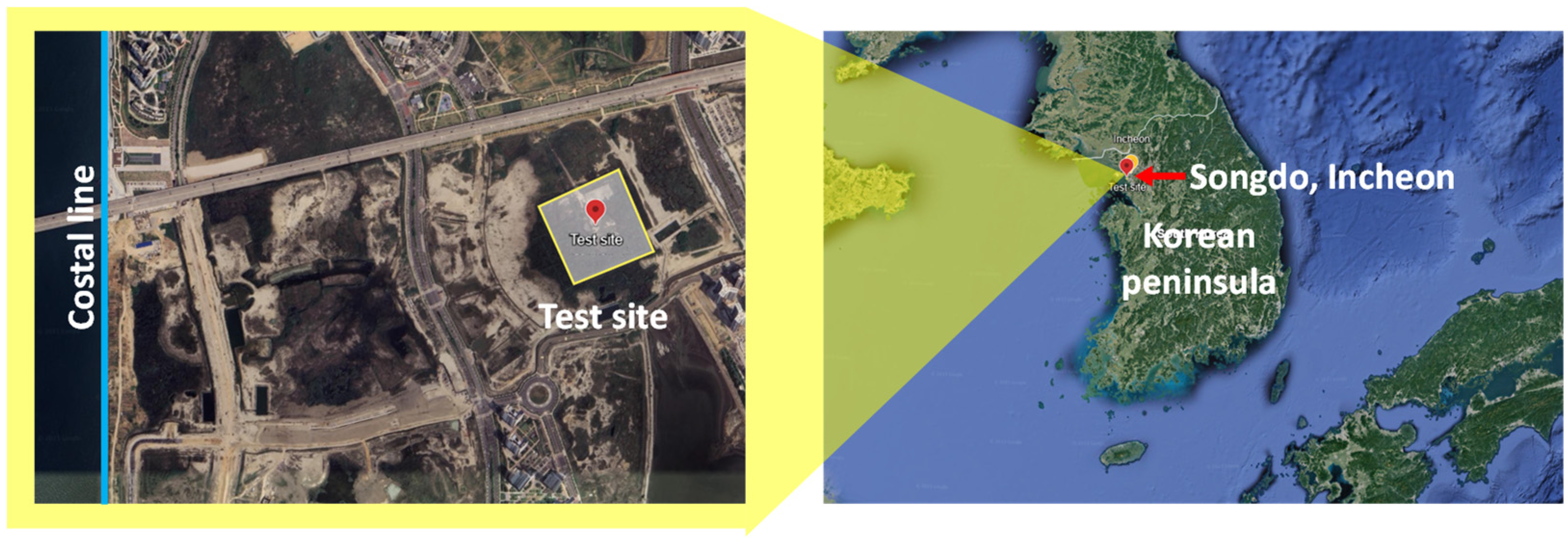
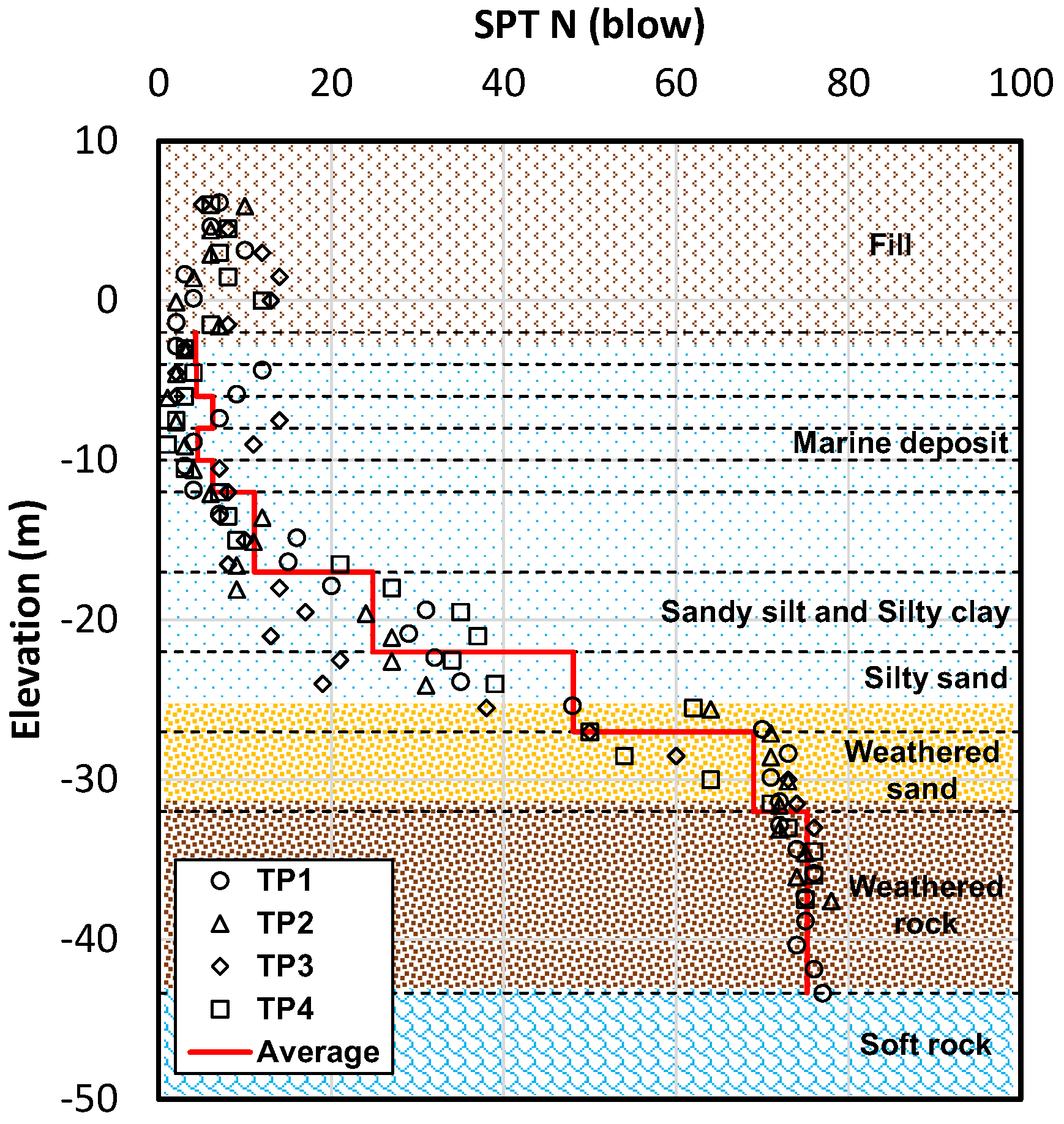
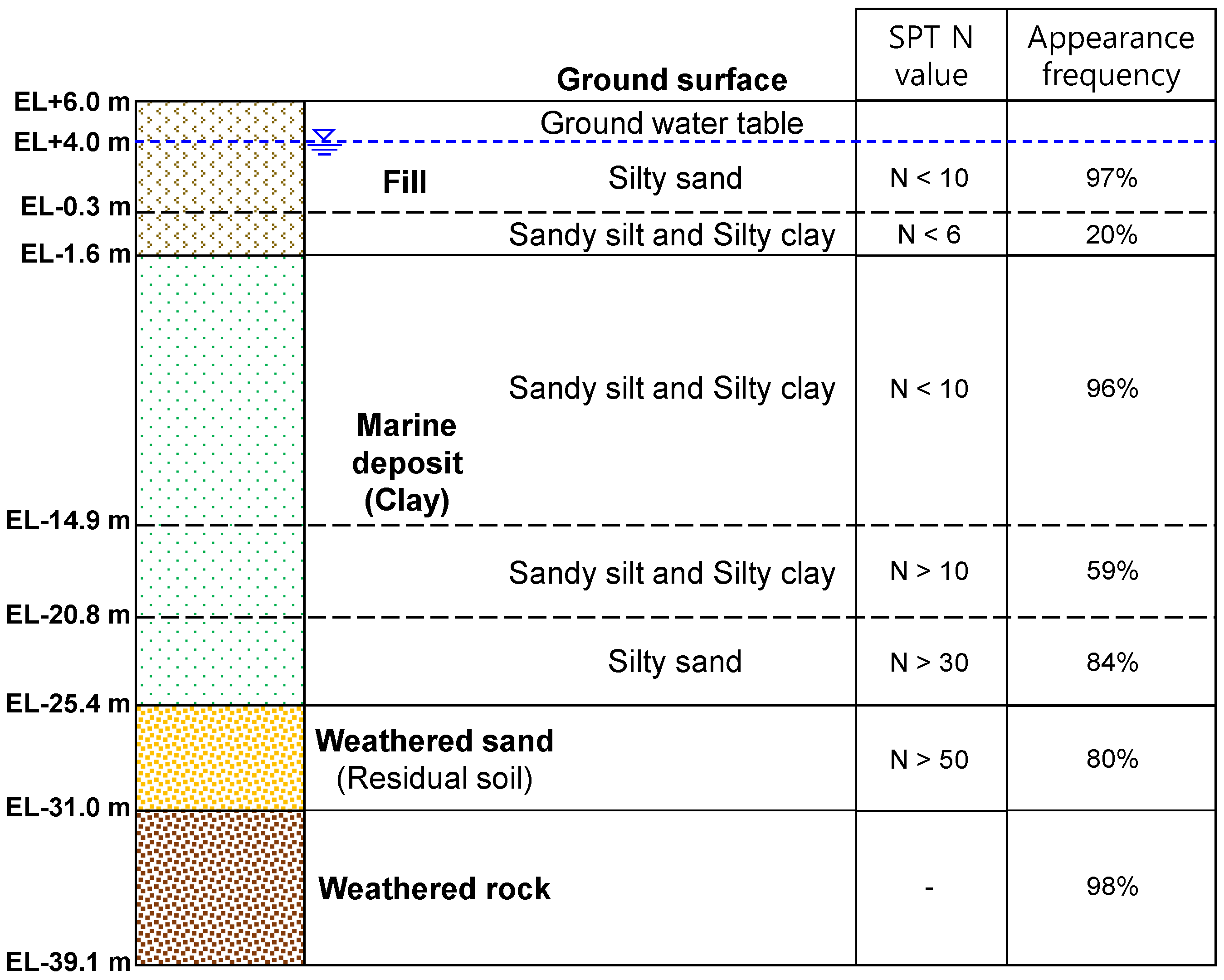


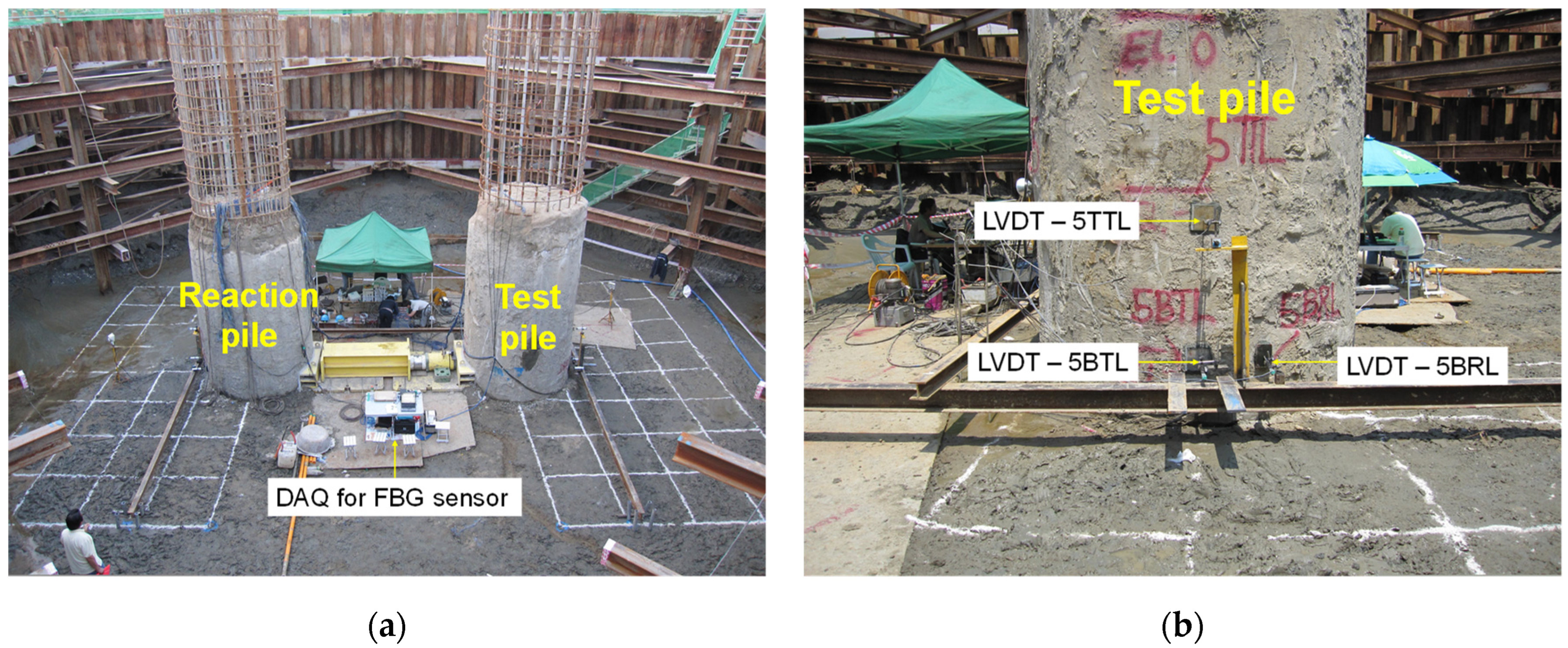
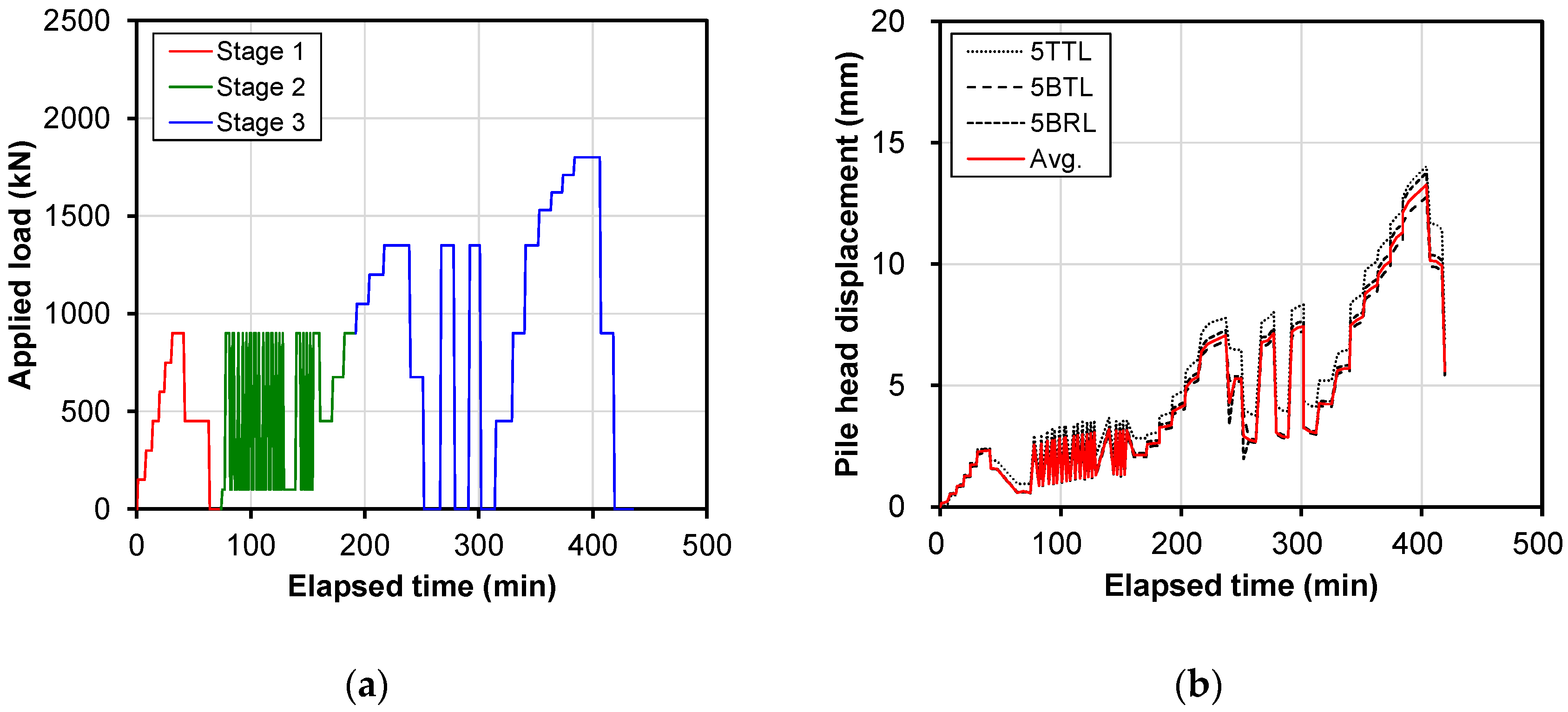
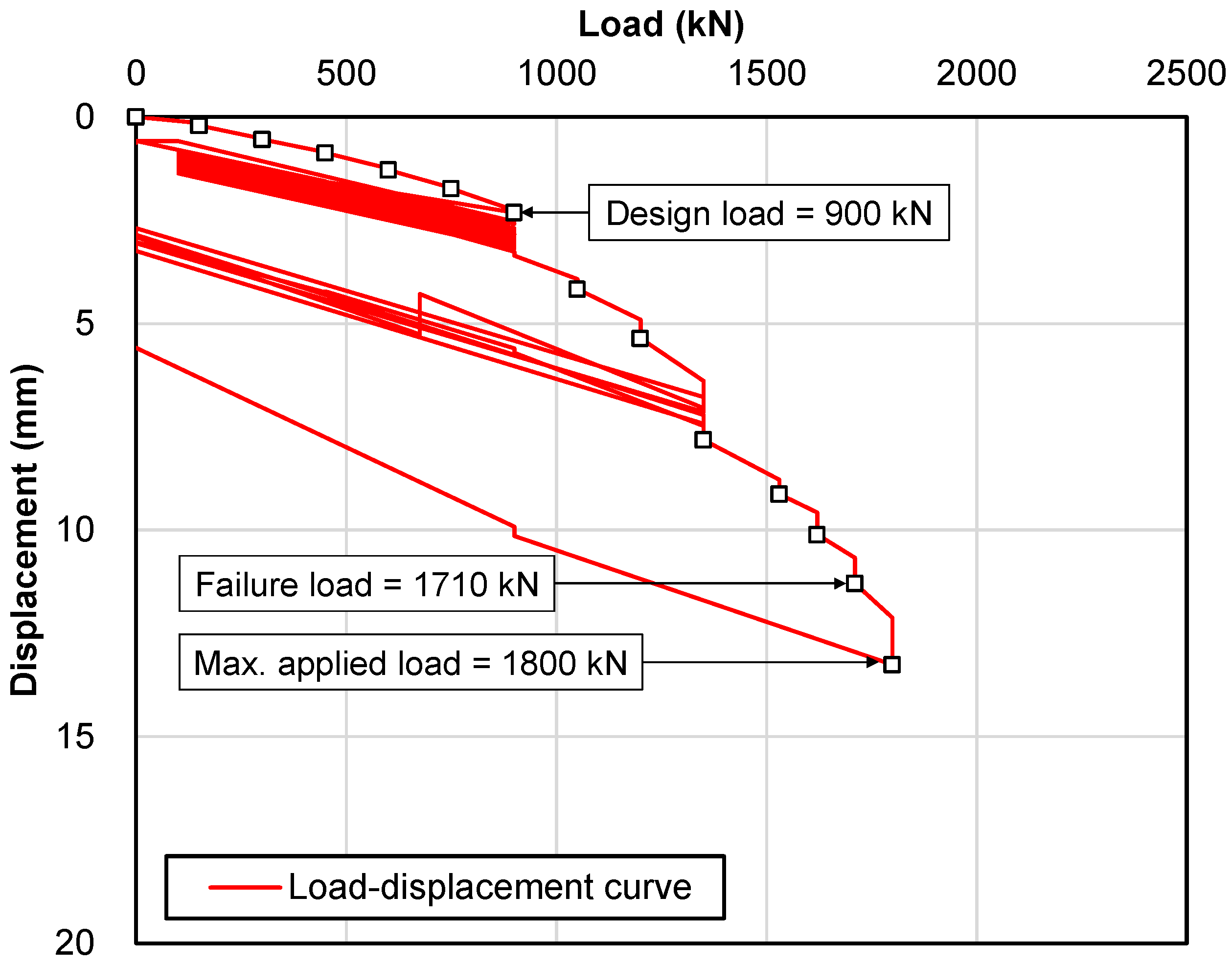
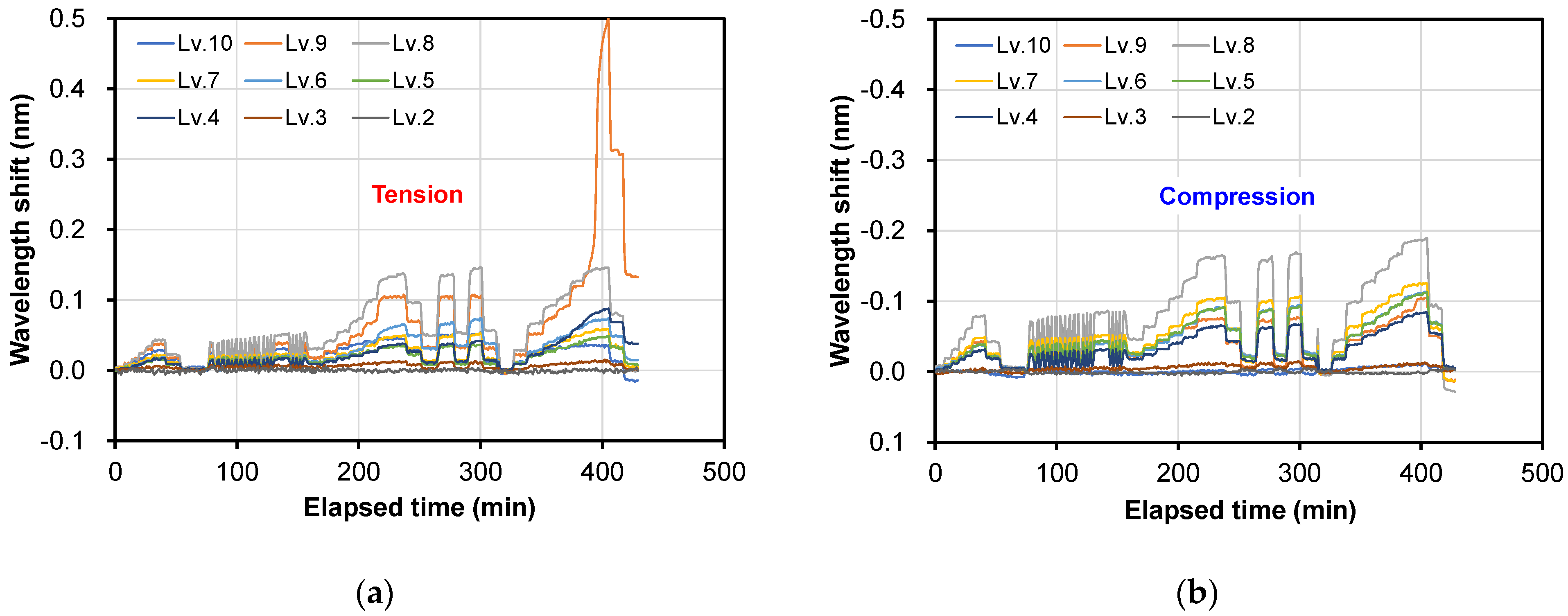
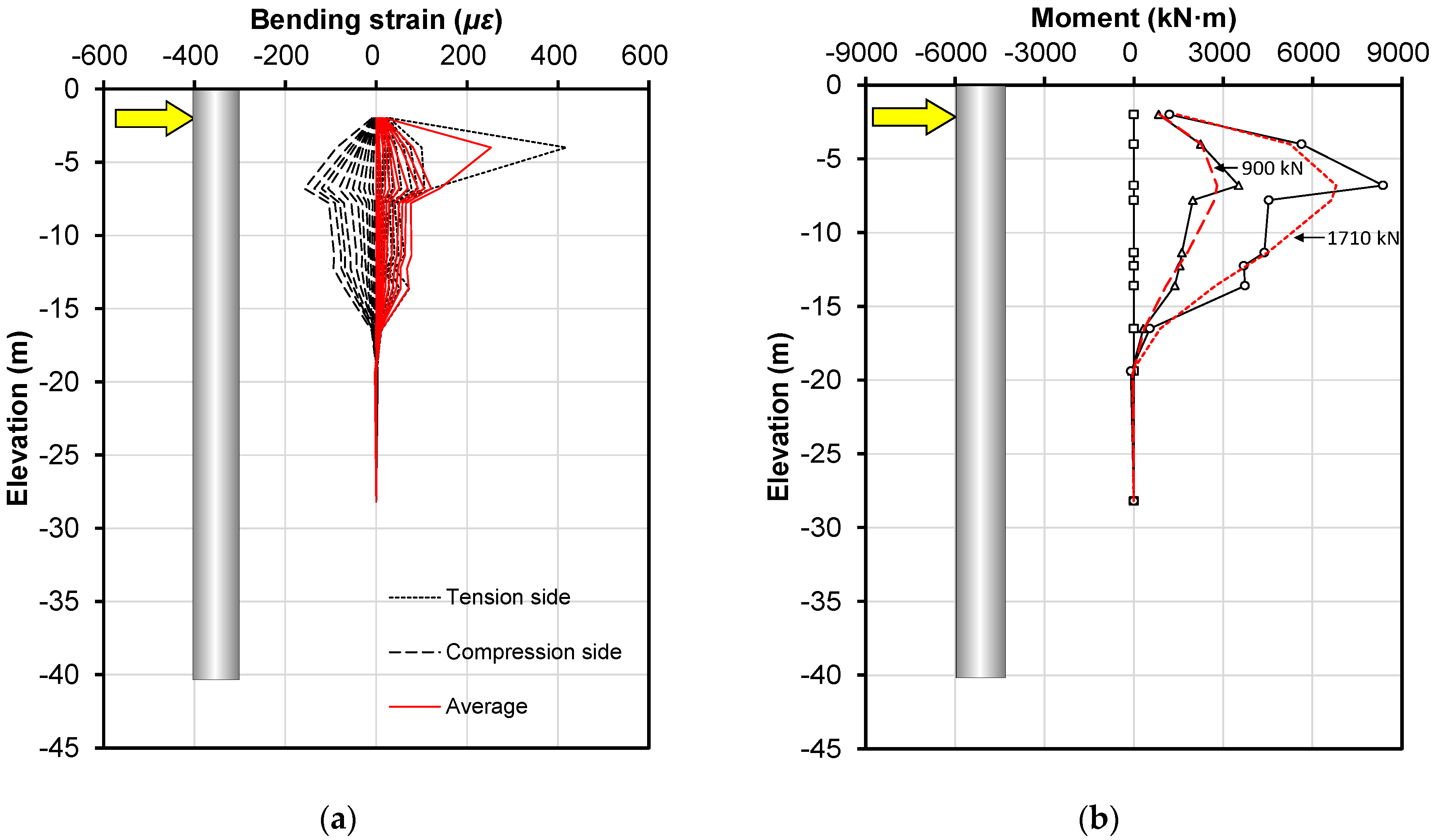

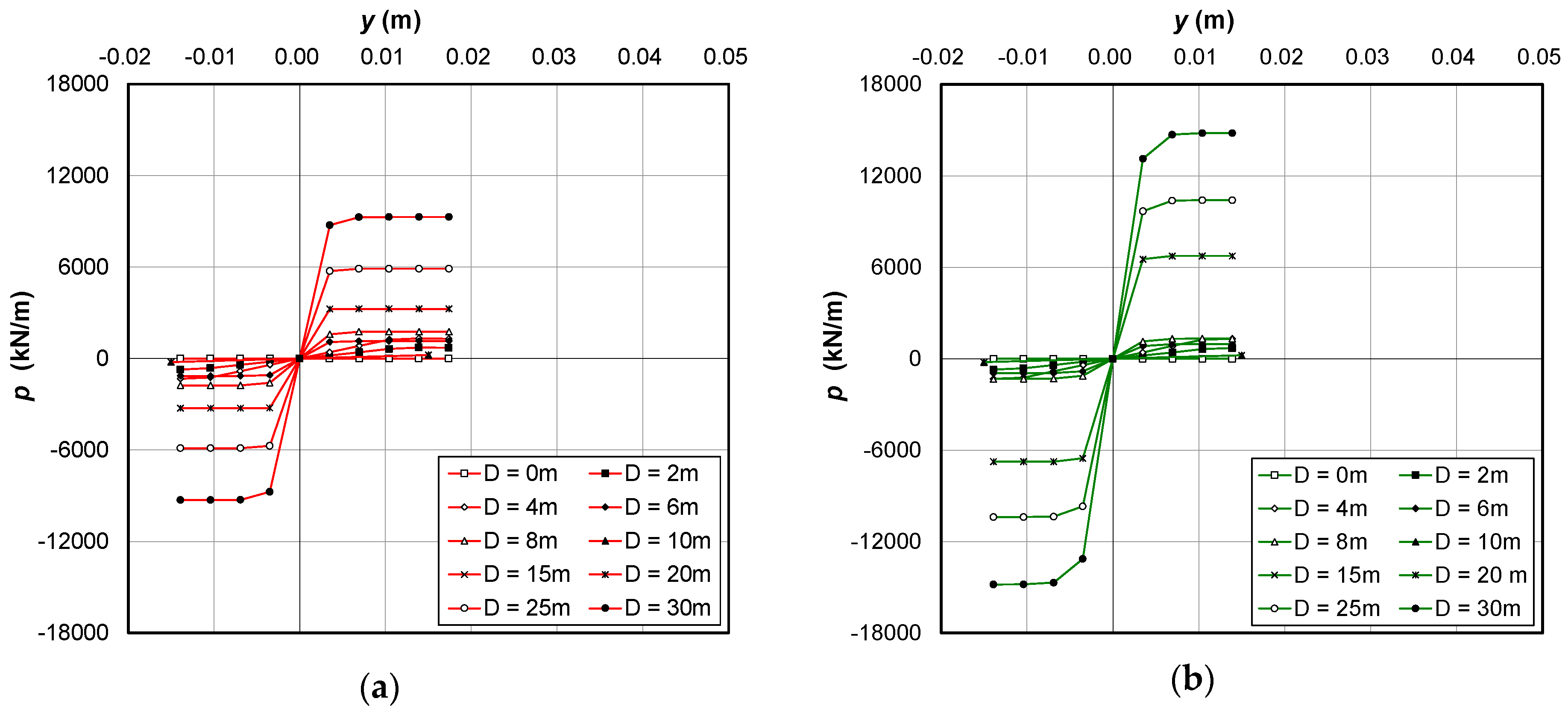
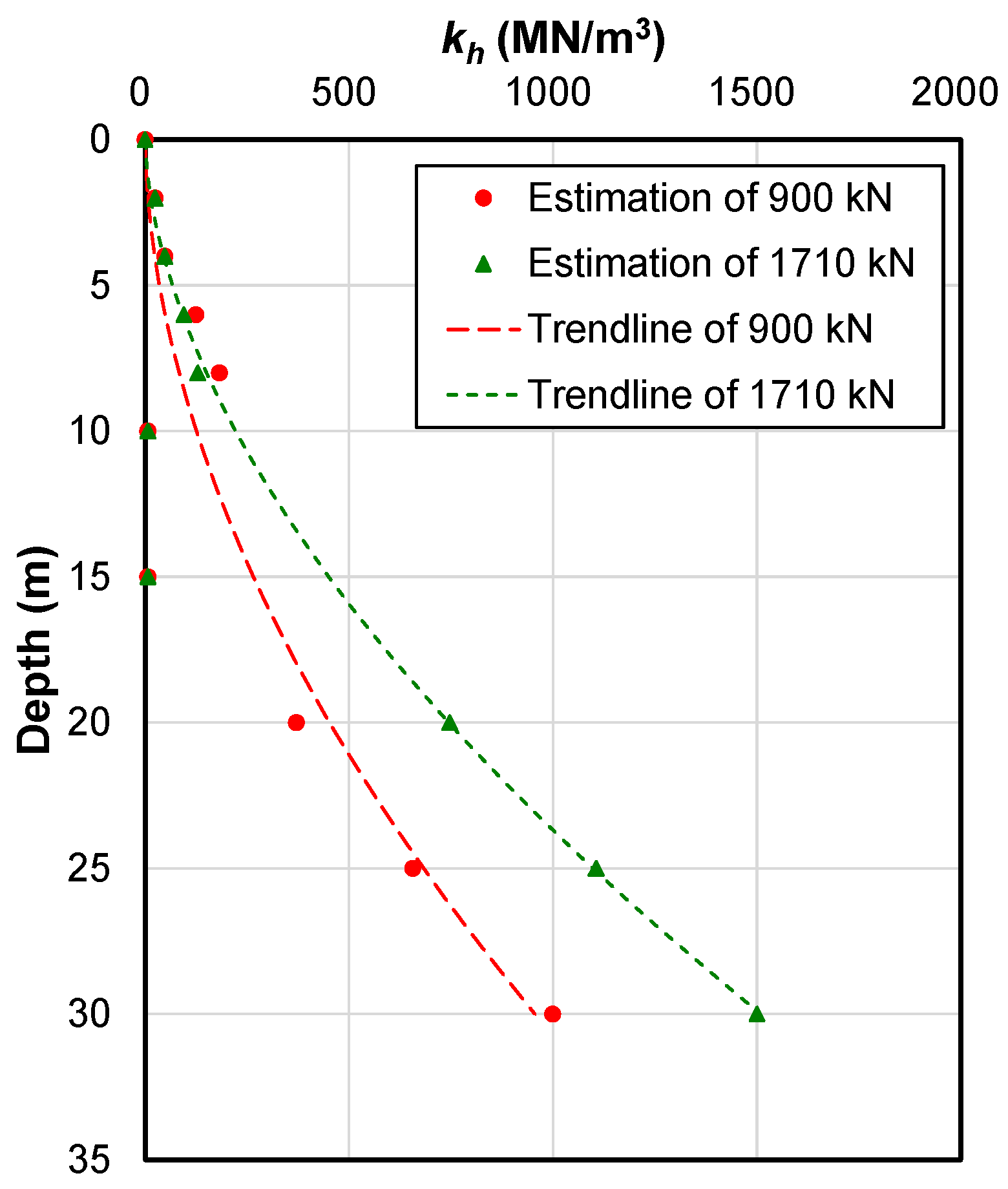

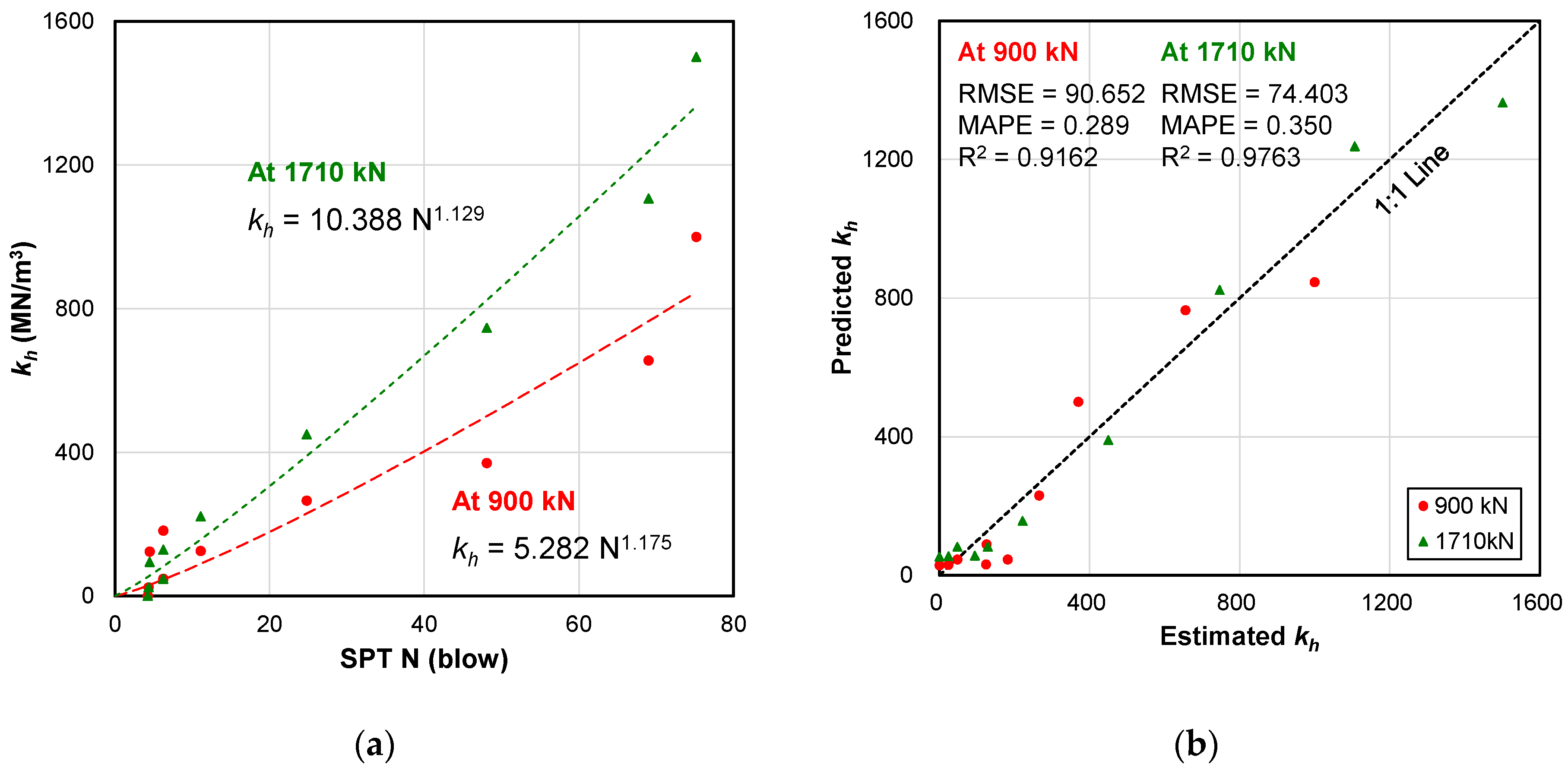
| Stratum | Properties | ||||||
|---|---|---|---|---|---|---|---|
| Undrained Shear Strength (cu, kPa) | Friction Angle (ϕ, °) | Total Unit Weight (γt, kN/m3) | Poisson Ratio (ν) | Vertical Modulus (Ev, MPa) | Horizontal Modulus (Eh, MPa) | USCS | |
| Fill | 30 | - | 17.5 | 0.3 | 7–15 | 5–11 | SM |
| Marine deposit | 60 | - | 17.8 | 0.3 | 30 | 21 | ML/CL |
| Weathered sand | - | 34 | 17.8 | 0.3 | 60 | 42 | SM |
| Weathered rock | - | 32 | 20.2 | 0.25 | 200 | 140 | Granite gneiss |
| Soft rock | - | 33 | 20.5 | 0.25 | 300 | 210 | Granite gneiss |
| Category | Input Variable | Applied Value | |
|---|---|---|---|
| Pile specification | Length (m) | 40 | |
| Diameter (m) | 2.5 | ||
| Elastic modulus (Conc, kN/m2) | 40,000,000 | ||
| Moment of inertia (m4) | 1.917 | ||
| Soil property | Cohesion (kN/m2) | 30 | |
| Friction angle (ϕ) | 30 | ||
| Unit weight (kN/m3) | 18–20 | ||
| Modulus of subgrade reaction (kN/m3) | Marine deposit (CL) | 30,000 | |
| Deposit (SM) | 60,000 | ||
| Weathered soil (SM) | 200,000 | ||
| Weathered rock | - | ||
| Loading condition | Pile head | Free | |
| Applied load (kN) | 900/1710 | ||
| Assumed Pile Length (m) | Assumed Bearing Strata | Applied Load (kN) | Maximum Moment (kN·m) | Lateral Deformation (mm) | ||
|---|---|---|---|---|---|---|
| Inverse Analysis | Measurement | Inverse Analysis | Measurement | |||
| 40 | Soft rock | 900 | 3673.4 | 3520.2/2792.3 * | 2.64 | 2.32 |
| 1710 | 6839.6 | 8364.9/6798.4 * | 5.32 | 11.30 | ||
Disclaimer/Publisher’s Note: The statements, opinions and data contained in all publications are solely those of the individual author(s) and contributor(s) and not of MDPI and/or the editor(s). MDPI and/or the editor(s) disclaim responsibility for any injury to people or property resulting from any ideas, methods, instructions or products referred to in the content. |
© 2024 by the authors. Licensee MDPI, Basel, Switzerland. This article is an open access article distributed under the terms and conditions of the Creative Commons Attribution (CC BY) license (https://creativecommons.org/licenses/by/4.0/).
Share and Cite
Kim, M.; Kim, Y.; Ko, J. Full-Scale Lateral Load Test of Large-Diameter Drilled Shaft for Building Construction on Marine Deposits. Buildings 2024, 14, 2596. https://doi.org/10.3390/buildings14092596
Kim M, Kim Y, Ko J. Full-Scale Lateral Load Test of Large-Diameter Drilled Shaft for Building Construction on Marine Deposits. Buildings. 2024; 14(9):2596. https://doi.org/10.3390/buildings14092596
Chicago/Turabian StyleKim, Mintae, Youngsang Kim, and Junyoung Ko. 2024. "Full-Scale Lateral Load Test of Large-Diameter Drilled Shaft for Building Construction on Marine Deposits" Buildings 14, no. 9: 2596. https://doi.org/10.3390/buildings14092596
APA StyleKim, M., Kim, Y., & Ko, J. (2024). Full-Scale Lateral Load Test of Large-Diameter Drilled Shaft for Building Construction on Marine Deposits. Buildings, 14(9), 2596. https://doi.org/10.3390/buildings14092596







